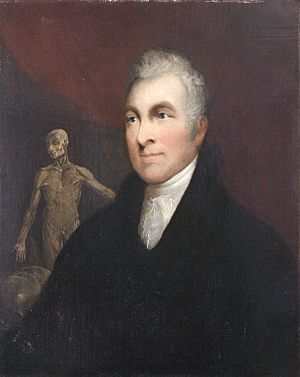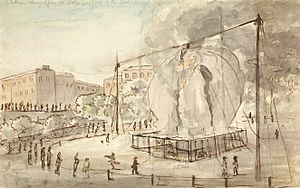John Sheldon (anatomist) facts for kids
John Sheldon (born July 6, 1752 – died October 8, 1808) was an English doctor who specialized in surgery and studying the human body (anatomy). He made important contributions to medicine and even tried to fly in a hot air balloon!
Contents
Sheldon's Medical Career
John Sheldon was born in London in 1752. He began his medical training by learning from Henry Watson, who was a leading anatomy teacher. Sheldon studied and taught about the human body at Watson's private museum in London. Sadly, this museum was later destroyed.
Sheldon became a qualified surgeon in 1775. After that, he taught anatomy at the famous Great Windmill Street school, working with another well-known anatomist, William Hunter. Sheldon also worked as a surgeon at a hospital in Welbeck Street. In 1782, he took over from William Hunter as the professor of anatomy at the Royal Academy. This was a very important position!
In 1784, Sheldon was chosen to be a member of the Royal Society, which is a group of top scientists. He also worked as a surgeon at Westminster Hospital for two years.
Sheldon as a Teacher
In 1777, Sheldon opened his own private school in Great Queen Street, London. Here, he taught anatomy and did his own research. After some other famous teachers passed away, Sheldon became one of the most important young teachers in his field. Many students learned from him, including Thomas Beddoes and Joshua Brookes. He even hired Charles Brandon Trye to help him at his school.
When Sheldon moved away from London, another anatomist named James Wilson took over his house and continued teaching there.
Later Life and Health
Around 1788, John Sheldon faced some challenges with his mental health. He believed he had found an easy way to catch whales using special harpoons. He even traveled to Greenland to test his idea. However, he had to be sent back on another ship. From then on, he had periods of poor mental health, which doctors today believe might have been a condition called bipolar disorder.
Sheldon later moved to Exeter. There, he continued his medical work and was chosen as a surgeon for the Devon and Exeter Hospital in 1797.
John Sheldon passed away at his home near the River Exe on October 8, 1808.
Sheldon the Balloonist
Some people say that John Sheldon was the first Englishman to fly in a hot air balloon. However, another person named James Tytler from Scotland actually flew earlier, in August 1784.
Sheldon tried to fly his own balloon on August 16, 1784. But his balloon, which was tied down, caught fire!
The first person to successfully fly a balloon in England was Vincent Lunardi, on September 15, 1784. Just ten days later, on September 25, Sheldon tried again with his own Montgolfier balloon in London. Sadly, his balloon caught fire again, and he and his companion couldn't get off the ground. This attempt was even made fun of in a cartoon!
Later that year, a French balloonist named Jean-Pierre Blanchard came to England. Sheldon flew with him on October 16. They carried scientific tools, but the balloon couldn't go high enough. Blanchard had to throw some tools overboard! They landed, and Blanchard continued the flight alone. Sheldon later tried to get the Royal Society to support more balloon flights, but it didn't happen.
Sheldon's Important Works
Sheldon spent a lot of time studying the lymphatic system, which is a network in your body that helps fight infections. Another doctor, William Cumberland Cruikshank, also worked on this area. Sheldon was also very interested in embalming, which is a way to preserve bodies. Both of these interests came from his teacher, William Hunter, and Sheldon worked on them throughout his life.
Sheldon famously embalmed the body of a young woman. There are different stories about this. One story says she was a patient who died from a lung illness, and he embalmed her himself. Another story says she was someone he knew, and William Hunter helped him embalm her. Sheldon's wife later gave the preserved body to the Royal College of Surgeons.
Sheldon also wrote some important books:
- The History of the Absorbent System, published in London in 1784. This book was about the lymphatic system.
- An Essay on the Fracture of the Patella or Kneepan... published in London in 1789. This book was about broken kneecaps.
He also helped edit a book by another scientist named Johann Nathanael Lieberkühn.



